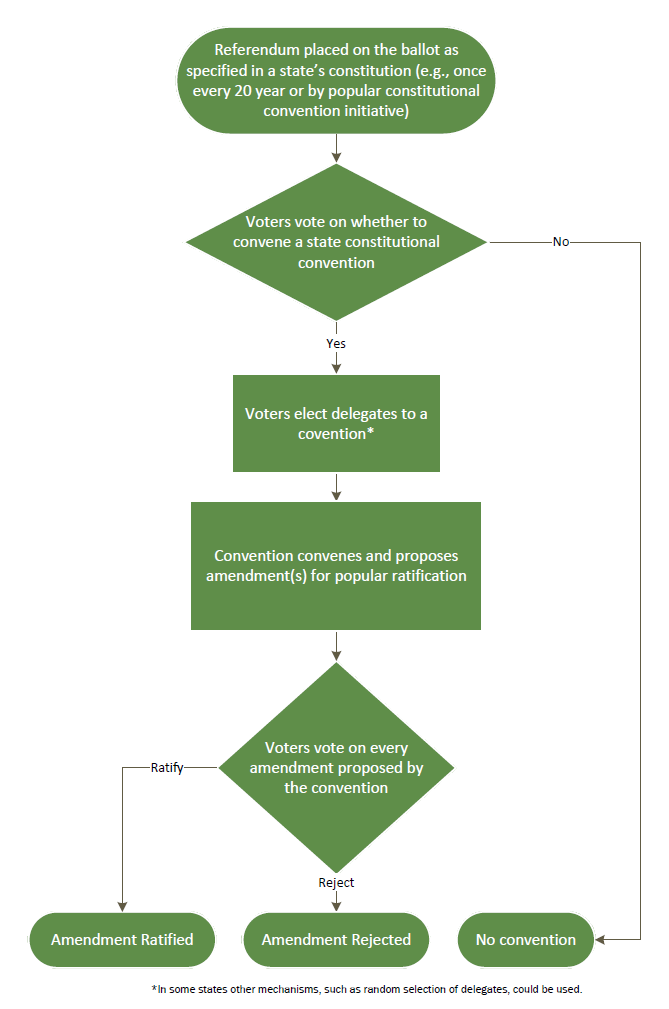State Color Code*
PINK — Constitutions with the mandatory periodic constitutional convention referendum.
PURPLE — Constitutions with the explicit constitutional convention popular initiative.
GREEN — Constitutions with both of the above constitutional convention mechanisms.
* States that may be able to use the popular initiative to call a constitutional initiative can be found here.
Next Referendum
Next Delegate Election
Referendums From 2014
Alaska, November 8, 2022
Missouri, November 8, 2022
New Hampshire, November 8, 2022
U.S. Virgin Islands, Nov. 3, 2020*
Iowa, November 3, 2020
U.S. Virgin Islands, November 3, 2020
Hawaii, November 6, 2018
New York, November 7, 2017
Rhode Island, November 4, 2014
* Voters approved the convention call.
Op-Eds on Rhode Island’s Nov. 5, 2024 Referendum
Snider, J.H., Legislature Subverting State’s ConCon Process, Providence Journal, June 23, 2024. A copy of the article as published in the print edition can be found here.
Snider, J.H., and Gary Sasse, It’s past time for RI to prep for Nov. 5 constitutional convention, Providence Journal, May 12, 2024. A copy of the article as published in the print edition can be found here.
Op-Eds and Policy Briefs on U.S. Virgin Islands 2023 Constitutional Convention Enabling Act
Snider, J.H., Policy Brief: The Proper Scope of USVI’s Constitutional Convention, USVI Constitutional Convention Clearinghouse, January 2, 2024.
Snider, J.H., Policy Brief: Fixing USVI’s Constitutional Convention Enabling Act, USVI Constitutional Convention Clearinghouse, March 27, 2023, revised with addendum on January 1, 2024.
Snider, J.H., USVI’s End-run Against America’s State Constitutional Tradition, Constitutional Conversations (a publication of the Center for Constitutional Design based at the Sandra Day O’Connor College of Law), June 7, 2023.
Snider, J.H., Implementing the Constitutional Convention Voters Approved in 2020, The Virgin Islands Consortium, March 24, 2023.
Snider, J.H., Where a U.S. Territory Can’t Get Its Own Constitution: A Self-Serving Legislature Drives the Plot in a Story of Democratic Failure, Zocalo Public Square, March 2, 2023.
Op-Eds on Alaska’s Nov. 8, 2022 Referendum
- Snider, J.H., Part IV: Reforming constitutional convention campaigns, The Fulcrum, Jan. 30, 2023.
- Snider, J.H., Part III: The failed constitutional convention campaign finance marketplace, The Fulcrum, Jan. 23, 2023.
- Snider, J.H., Part II: Deterrence helps explain the spending spree, The Fulcrum, Jan. 16, 2023.
- Snider, J.H., Part I: Alaska’s constitutional convention spending spree, The Fulcrum, Jan. 9, 2023.
- Snider, J.H., Congrats to the anti-ConCon coalition: They’ve run a brilliant campaign, Juneau Empire, Nov. 1, 2022.
- Snider, J.H., The lieutenant governor’s sizable role in the constitutional convention, Fairbanks Daily News-Miner, Oct. 20, 2022. For a copy of the article in the format of a news clipping, click here.
- Snider, J.H., Why is a convention referendum on the ballot this fall?, Juneau Empire, Oct. 6, 2022.
- Snider, J.H., Apparent biases at work in creating pro-ConCon statement, Juneau Empire, June 8, 2022.
- Snider, J.H., Derailing Alaska’s Constitutional Convention Referendum, Fairbanks Daily News-Miner, Feb. 20, 2022. For a copy of the article in the format of a news clipping, click here.
- Snider, J.H., Preparing for Alaska’s constitutional convention referendum, Juneau Empire, Feb. 9, 2022.
Op-Eds on Missouri’s Nov. 8, 2022 Referendum
- Snider, J.H., Missourians have a new opportunity to demand a constitutional convention, St. Louis Post-Dispatch, April 4, 2022.
- Snider, J.H., Appellate judges should call a jury to pick state Senate’s redistricting map, St. Louis Post-Dispatch, Jan. 24, 2022.
Op-Eds on New Hampshire’s Nov. 8, 2022 Referendum
- Snider, J.H., Why Vote for a Con-Con Nov. 8th? Top-Four Primary With Ranked-Choice Voting, New Hampshire Journal, Oct. 16, 2022.
- Snider, J.H., Why is ‘con con’ on the Nov. 8 ballot?, Concord Monitor, Oct. 16, 2022.
- Snider, J.H., Why is the constitutional convention question on the fall ballot?, New Hampshire Union Leader, May 6, 2022. Note that this is substantially the same op-ed as the one published below in the New Hampshire Journal.
- Snider, J.H., Why Is a Constitutional Convention Question on NH Ballot This Fall?, New Hampshire Journal, April 28, 2022.
Op-Ed on Iowa’s Nov. 3, 2020 Referendum
- Snider, J.H., It’s time to talk about a constitutional convention, The Globe Gazette, November 1, 2020.
- Snider, J.H., Iowa’s constitutional convention process, a triumph of democracy, could be improved, The Gazette, October 10, 2020.
- Snider, J.H., 3 things Iowans should consider about constitutional convention referendum, Iowa City Press-Citizen, September 21, 2020.
- Snider, J.H., Regular Iowans can change things by voting for a constitutional convention on Nov. 3, Des Moines Register, August 16, 2020.

Agave Americana, popularly known as the American Century Plant, is a plant that flowers once every 10 to 30 years in perpetuity via clone daughter plants. Its periodic and beautiful flowering is symbolic of the periodic state constitutional convention referendum. A consequence of the plant’s flowering so infrequently is that people forget it’s a flowering plant by the time it next flowers.
Course, Symposium, and Essay
A Political Primer on the Periodic State Constitutional Convention Referendum
Short course held at the Annual Meeting of the American Political Science Association, Philadelphia Convention Center, Wednesday, August 31, 2016, 2:00 pm to 6:00 pm. Produced by J.H. Snider. The first part of the course, which included TV documentaries and pro & con political ads, can be found here.
A symposium summarizing the short course was published by the Law and Courts Section of the American Political Science Association. See Symposium: The Politics of State Constitutional Reform, Law and Courts Newsletter, Fall 2016. The symposium contributors were J.H. Snider, Sanford Levinson, John Dinan, and Carol Weissert.
Background reading, including references to major works in this literature, can be found at J. H. Snider, Does the World Really Belong to the Living? The Decline of the Constitutional Convention in New York and Other US States, 1776–2015, Journal of American Political Thought 6, no. 2 (Spring 2017): 256-293.
“If it be asked what the American Revolution distinctively contributed to the world’s stock of ideas, the answer might go something along these lines…. The problem throughout much of America and Europe, for half a century, was to ‘constitute’ new government…. America solved the problem by the device of the constitutional convention…. The constitutional convention in theory embodied the sovereignty of the people. The people chose it for a specific purpose, not to govern, but to set up institutions of government…. The constitution was written and comprised in a single document. The constitution and accompanying declaration, drafted by convention, must, in the developed theory, be ratified by the people. The convention thereupon disbanded and disappeared, lest its members have a vested interest in the offices they created. The constituent power went into abeyance, leaving the work of government to the authorities now constituted…. There were two levels of law, a higher law or constitution that only the people could make or amend…. Such was the theory, and it was a distinctively American one…. European thinkers… lacked the idea of the people as a constituent power.”
–R.R. Palmer, The Age of the Democratic Revolution:
A Political History of Europe and America, 1760-1800,
Princeton University Press, 2014, pp. 159-161.
Decision Tree Diagram of the Generic Periodic Convention Referendum Process
At the “Unrig the System Summit” in Nashville, Tennessee on March 31, 2019, J.H. Snider explains that America has two constitutional mechanisms at the state level to bypass a legislature’s gatekeeping power over constitutional reform: the well known and often utilized popular constitutional initiative, and the little known and relatively rarely used periodic constitutional convention referendum. Click on the video, which will open in a different window.
Text Description of Recent
Periodic State Constitutional Conventions Processes
Introduction
 Since the late 18th century, the institution of the state constitutional convention has evolved substantially. For example, it was rare until the 19th century to have a popular election to either convene a state constitutional convention or to ratify its recommendations. Many state constitutional conventions also had legislatively appointed rather than popularly elected delegates. By the 20th century, however, popular elections to convene a state constitutional convention and then ratify its recommendations became the norm, as did popular election of delegates.
Since the late 18th century, the institution of the state constitutional convention has evolved substantially. For example, it was rare until the 19th century to have a popular election to either convene a state constitutional convention or to ratify its recommendations. Many state constitutional conventions also had legislatively appointed rather than popularly elected delegates. By the 20th century, however, popular elections to convene a state constitutional convention and then ratify its recommendations became the norm, as did popular election of delegates.
The periodic state constitutional convention, which is a variant of the state constitutional convention, is a relatively recent institutional innovation. By the end of the 18th century, only one U.S. state had it; by the end of the 19th, seven; and by the end of the 20th century, fourteen.
As a general rule, provisions for periodic state constitutional conventions have evolved to become both more detailed and less tolerant of legislative control of key stages of the process. During the past one hundred years, periodic state constitutional conventions have generally shared the following eight stages; the three stages where the public has voted are highlighted in red.)
Note that this is only an idealized outline that skips vital procedural details that vary from state to state. The Comparative Features and State Rankings web pages of this website focus on clarifying the significance of some of that procedural variation.
Stages of a Convention
- A government agent (such as the legislature or secretary of state) places the periodic referendum on the ballot.
- Voters vote on the referendum.
- A government agent determines whether the referendum has been approved.
- If the answer is yes, a government agent arranges for the election of delegates to and the subsequent convening of the convention.
- Candidates register to run for delegate.
- Voters vote for delegates.
- Delegates meet as a public body (the “constitutional convention”), deliberate on proposed constitutional amendments, and then vote on which ones to place on the ballot for voter ratification.
- Voters vote on whether to ratify the proposed amendments.
Key Accountability Mechanisms
Introduction
A state constitutional convention does not have unlimited power. It is subject to major checks, the most notable of which are approval of everything it proposes by the voters and compatibility with the U.S. Constitution of any proposals the voters approve. The various major checks are listed below, with the checks by other branches of government, excluding the state legislature, highlighted in red.
Checks on the Convention
- Voters vote on a referendum on whether to convene a state constitutional convention.
- Voters vote for delegates to the state constitutional convention via competitive elections.
- The elected delegates meet as a public body (the “constitutional convention”), which deliberates and votes in public on proposed constitutional amendments and then only places on the ballot for voter approval those proposals that receive a majority vote of the delegates.
- After the adjournment of the constitutional convention, the proposed amendments are published for the public to deliberate upon for an extended period of time before being asked to vote on them.
- Voters vote on whether to ratify the proposed amendments.
- The ratified laws must be consistent with U.S. government law, including the U.S. Constitution, U.S. Supreme Court case law, Congressional statutes, and federal rulemakings, all of which may be changed at any time.
- The state legislature may rescind or amend any of the ratified laws via ordinary legislatively initiated and voter ratified constitutional amendments .*
- The ratified amendments are subject to judicial interpretation.*
* This assumes that the proposals the voters ratified didn’t restrict legislatively initiated constitutional revision or judicial review.
Key Limits on the Legislature’s
Ability to Control the Process
Introduction
The amount of legislative control over the periodic state constitutional convention process is one of the key areas where state constitutions vary. For example, some states allow legislators to run as delegates; others ban it. The following lists some of the shared constitutional limitations on legislatures as of the early 21st century. In practice, these limitations aren’t absolute, as legislatures have sometimes found politically feasible ways to circumvent them. The key feature, which explains the universal hostility of legislatures to the periodic state constitutional convention, is the absence of legislature agenda control and is marked in red.
Limits on the Legislature
- The legislature cannot prevent the people from having an opportunity to vote on whether to convene a state constitutional convention.
- The legislature must allow the people to convene a state constitutional convention if the requisite majority of people votes in favor of one.
- The legislature cannot directly gerrymander the districts from which the state constitutional convention delegates are elected.
- The legislature cannot control the state constitutional convention’s internal procedures.
- The legislature cannot limit the state constitutional convention’s agenda.
“[T]o reduce the scope for institutional interest, constitutions ought to be written by specially convened assemblies and not by bodies that also serve as ordinary legislatures. Nor should the legislatures be given a central place in the process of ratification. In both these respects, the [1987 U.S.] Federal Convention can serve as a model.”
“The important distinction so well understood in America, between a Constitution established by the people and unalterable by the government, and a law established by the government and alterable by the government, seems to have been little understood and less observed in any other country. Wherever the supreme power of legislation has resided, has been supposed to reside also a full power to change the form of the government.”


